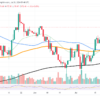
Cardano has been building a solid foundation that could support its rise towards the $1 mark, indicating an uptrend on the horizon. ADA price analysis shows a resilient structure as it bounces between significant support and resistance levels, setting the stage for a possible rise.
Cardano has been building a solid foundation that could support its rise towards the $1 mark, indicating an uptrend on the horizon. ADA price analysis shows a resilient structure as it bounces between significant support and resistance levels, setting the stage for a possible rise.
At the moment, ADA is trading near $0.79, showing resistance and potential for bullish movement. Local support level can be identified around the $0.58 mark, where the 50-day moving average has provided a reliable safety net during pullbacks. This level has consistently fostered buying pressure, driving the price higher.

On the resistance side, the $0.87 level is critical. It has previously acted as a barrier to future price increases. A break above this resistance could signal significant bullish momentum, possibly pushing ADA towards the $1 target. However, this would require a considerable increase in volume to sustain such a move, as resistance levels often build up sell orders that could stop bullish moves.
Cardano’s DeFi ecosystem is showing impressive growth, drawing attention to ADA. This growing interest in Cardano’s DeFi capabilities could be a major catalyst for the rally, as more investors and users join the network, attracted by its potential in the decentralized finance space.
NEAR breaks another resistance
The Near Protocol (NEAR) has seen its value skyrocket, surpassing the $7 mark in a notable price increase. This rally is not just a solitary spike, but rather part of a sustained rally that reflects the active development work behind the scenes at Near and the prevailing market sentiment favoring time-tested cryptocurrencies.
When analyzing the price chart of NEAR, it is evident that the token has been on a steady rise. After breaking above the $4.50 resistance level, NEAR saw a rapid rise, indicating strong buying interest and investor confidence.
The $4.50 level, which previously acted as resistance, could now serve as local support, boosting the price during any potential pullback.
The significant volume increase accompanying the raise confirms the market’s enthusiasm for NEAR. As the protocol continues to build and deploy effective solutions in the decentralized finance and application space, the growth of its ecosystem has been a considerable driver of the rally.
NEAR’s current price action indicates a bullish trend, with the token’s value surpassing previous highs with relative ease. This upward trajectory is supported by strong fundamentals, including the platform’s scalability and performance capabilities.
Ethereum remains dominant
Ethereum continues to captivate the cryptocurrency market with an impressive rally that shows no signs of slowing down. As a leading altcoin, it not only sets the pace for the altcoin industry but also serves as the primary engine driving the current market rally.
Examining the ETH price chart, we observe a notable bullish trend. Ethereum has broken through multiple resistance levels and is now trading around the $4,050 mark. As we analyze the chart, a key resistance level to watch is the recent high around $4,200. If ETH can break above this point, there may be little resistance until the next psychological level of $4,500.
On the support side, Ethereum finds strong support at the $3,390 level, where the 50-day moving average lies. Historically, this moving average has acted as dynamic support in uptrends, allowing Ethereum to gain momentum for subsequent rallies. In the event of a price correction, this level could be the first test of Ethereum’s resistance.
There is a chance of a price reversal, as there is with any parabolic move, especially if the market gets too extended. However, Ethereum has yet to encounter major scalability issues that could slow the rally, largely thanks to Layer 2 (L2) solutions that have absorbed much of the demand that would normally overload the mainnet.























